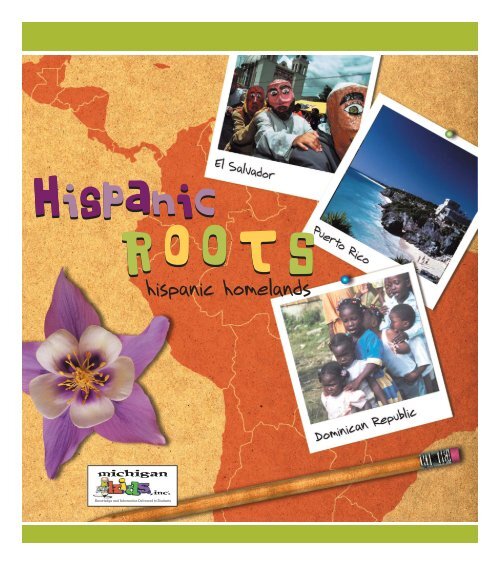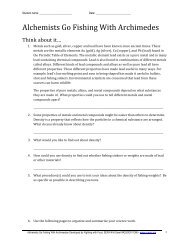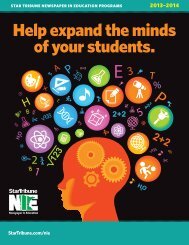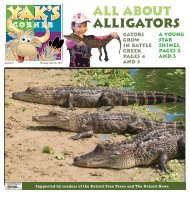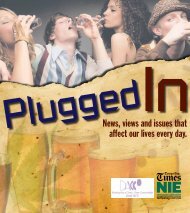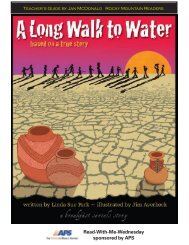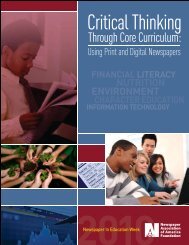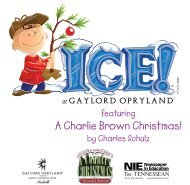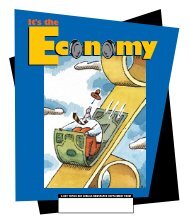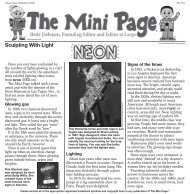hispanic homelands - Newspapers In Education
hispanic homelands - Newspapers In Education
hispanic homelands - Newspapers In Education
You also want an ePaper? Increase the reach of your titles
YUMPU automatically turns print PDFs into web optimized ePapers that Google loves.
HispanicROOTSO O T S<strong>hispanic</strong> <strong>homelands</strong>
Jasmine LandryThe influenceof Hispanic cultureIf you follow music, you know that Shakira, Juanes,Jennifer Lopez and Christina Aguilera are some of today’shottest stars.If you like movies, you know that Penelope Cruz, JavierBardem, Benicio Del Toro, Salma Hayek and AntonioBanderas are some of today’s biggest attractions.And if you follow baseball, you know that top players in“the American Pastime” are now Albert Pujols, Alex Rodriguez,Adrian Gonzalez, Carlos Beltran and Johan Santana.If you pay attention to American culture at all, you havenoticed that it has an increasingly Latino and Hispanic flavor,not only in entertainment and sports, but in food, fashion,dance and more.Statistics from the U.S. Census Bureau explain why:Hispanics are the fastest-growing minority in theUnited States and in the last few yearshave passed African Americans to become nation’s largestminority group.The Hispanic population in the U.S grew to 50.5 millionpeople in 2010, according to statistics released in March 2011.The growth rate of the Hispanic population has been nearlythree times the growth rate for the total U.S. population andaccounted for more than one-half of the nation’s overallpopulation growth of 27.3 million people since the year 2000.Hispanics now make up 16 percent of the U.S. population,or about one in every six people. The Census Bureau projectsthat Hispanics will account for one out of every threeAmericans by the year 2050.Though Hispanic Americans all come from Spanish-speakingbackgrounds, they are not all members of one race. They maybe white, black, South American <strong>In</strong>dian or a combinationthereof — and still consider themselves “Hispanic.”They also don’t all come from the same country. HispanicAmericans may come from Spain, Mexico, Puerto Rico,Guatemala, Cuba or any of the more than 20 Spanishspeakingcountries in the world.The wide range of backgrounds of Hispanic Americansmakes the U.S. Hispanic community a strong and diverseone. It also makes the overall community of America richer.This special newspaper section has been created to givea better understanding of the Hispanic American community.It explores the history and traditions that have shaped thelives of Hispanic Americans in their <strong>homelands</strong>.It examines the geography and natural features that provideboth beauty and a sense of place for Hispanic Americans.And it celebrates the achievements of Hispanics from allnations that are a source of pride for Hispanic Americans.By learning about “Hispanic Roots, Hispanic Homelands,”you will get a greater understanding of how Hispanics changeand enrich any land in which they choose to live.¡Mira!Zuma Press1. Hispanics are now the largest minority group in the United States. They also are involved inactivities ranging from politics to education to the arts. Scan stories and photos in the newspapertoday or for several days for Hispanics making news. Pick one and write a paragraph explainingwhy the person is featured. Then write out three questions you would like to ask this person if youmet face to face.2. Hispanic Americans come from many countries. Look for a story in the newspaper about aHispanic country. Write a few sentences summarizing what is making news there. Write anotherstating why that news would interest Hispanics in this country.Learning Standards/Skills: Locating and describing the diverse places, cultures and communitiesof world regions; describing how social changes in regions may have global consequences.Look!Gabriel Garcia MárquezShakiraThe Newspaper in <strong>Education</strong> supplement “Hispanic Roots, HispanicHomelands” was created by Hollister Kids for syndication to newspapersnationally. Copyright ©2005. All rights reserved. The writers were MarthaMichaela Brown, Sara Shahriari and Rachel Vigoda. The graphic designerwas Breonna Rodriguez. The Hollister Kids website is www.hollisterkids.com.2
Breonna RodriguezMexicoLocation:Just south of the United States,bordered on the east by the CaribbeanSea and the Gulf of Mexico betweenthe U.S. and Belize, and on the westby the North Pacific Ocean betweenthe U.S. and Guatemala.Area:1,972,550square kmCapital:Mexico CityPopulation:113,724,226Currency:Mexican PesoOverflowing with monuments, museums, murals, shrines andarchaeological discoveries, Mexico City is one of the largestcities in the world, and the oldest capital on the continent ofNorth America.Researchers estimate today that more than 9 million peoplelive within the borders of Mexico City — and that’s not countingthe 10 million that live in areas immediately outside the city.Mexico City was once the capital of the Aztec empire andwas called by the name Tenochtitlán. The Aztecs were great warriorsand builders. Their advanced civilization had sophisticatedtrading, farming, public schooling and even garbagecollectingsystems.Montezuma was the leader of the Aztecs when the Spanishcame in 1519. Unfortunately for his people, Montezuma mistookthe Spanish explorer Hernán Cortés for one of the Aztec gods,making it relatively easy for the Spanish to conquer the Aztecsand turn Mexico City into the center of Spain’s colonies.Mexicans coming to the United States make up the largestgroup of immigrants in the U.S. today, according to the U.S.Census Bureau.Guadalajara is the second-largest city in Mexico. It is wheremany famous Mexican creations, such as the sombrero hat andmariachi music, were first fashioned.Acapulco and Puerto Vallarta are two of Mexico’s biggestand most popular resort towns. People come from all over toenjoy the beautiful beaches. The more rural Yucatán Peninsulaarea is filled with sites built by the Mayan civilization, and alsoincludes another well-known vacation spot — Cancún.FamousMexicansArtist Diego Rivera,artist Frida Kahlo, writerCarlos Fuentes, NobelPrize winning poetOctavio Paz, astronautRodolfo Neri, Olympic-Gold-Medal boxer Oscarde la Hoya, Nobel Prizewinningchemist MarioMolina and rock and rolllegend Ritchie Valens.Frida Kahlo, Self-PortraitAgencia Reforma¿Lo sabías? Did You Know?Fiestas — from national holidays to local saints’ days to town fairs — are common in Mexico.One of the biggest is Día de los Muertos — the Day of the Dead. On this day just after Halloween,the souls of departed relatives and friends are supposed to return to Earth. For weeks beforehand,markets are filled with papier-mâché skeletons and skulls made from candy and sugar.¡Mira!Many Hispanic people now living in the United States have roots in Mexico. Mexican Americansare among the many ethnic groups who combine to create the population of the United States.Look through the newspaper for photos of different kinds of Americans: old, young, male,female, of various ethnicities, from different regions and countries, and with different jobs andways of life. Cut out the pictures to create an art collage of Americans. Then discuss ways inwhich differences can be challenging and how they can make the whole greater.Learning Standards/Skills: Identifying benefits and challenges of diversity in American life.Look!3
Puerto RicoLocation:Just east of the Dominican Republicin the Caribbean region, with theCaribbean Sea to the south and theAtlantic Ocean to the north.Area:8,959 square kmCapital:San JuanPopulation:3,989,133Currency:U.S. DollarPuerto Rico is a commonwealth of the United States, whichmeans its people are American citizens. <strong>In</strong>terestingly, more PuertoRicans now live in the mainland U.S. than live on the island.This page will focus on Puerto Ricans who live on the island.Puerto Ricans have a culture created by the many differenttypes of people who have lived there over the past 600 years.Before Christopher Columbus visited the island in 1493, nativepeoples called Taínos lived there, fishing and farming. When JuanPonce de León arrived to colonize the island for Spain in 1508,the Spaniards enslaved the Taínos.Most of them eventually died of disease or from battles with theSpanish. However, many children who were half Spanish and halfTaíno had been born, and the mixing of people in Puerto Rico hadbegun. When the Spanish no longer had enough Taínos to workas slaves, they brought African slaves to the island. African peopleand their traditions soon were mixed into the diverse culture of theisland. Today, many Puerto Ricans share both the ancestry and thecultures of the different groups of people who came to the island.Although Puerto Rico's history of slavery and oppression is bothsad and violent, most people on the island today exist in harmonyand appreciate the various influences that make their cultureunique and exciting.Puerto Rico is known for music, dance and art that combineelements of African, Taíno and European cultures, and for tourismthat continues to draw people from around the world.A modern dilemma for Puerto Ricans is whether or not theywant remain a commonwealth of the United States, become astate or become a country completely independent from the U.S.As a commonwealth, Puerto Ricans who live on the island electtheir own governor, but they are not able to vote for presidentor elect senators to represent them in the U.S. government.Their representation in Congress is limited to a single, non-votingdelegate to the House of Representatives called the residentcommissioner. However, on the plus side, island-dwelling PuertoRicans only have to pay local income taxes — not federal. Thedebate about what to do is ongoing.FamousPuertoRicansSinger Ricky Martin,baseball Hall of FamerRoberto Clemente, actorRita Moreno, artistRafael Tufino, authorRosario Ferré and formerU.S. Surgeon GeneralAntonia Coello Novello.Jazz and mambo legendTito Puente andsinger/actor JenniferLopez are of PuertoRican descent.ReutersTito Puente¿Lo sabías? Did You Know?Puerto Rico's El Yunque National Park is the only park under the U.S. Forest Service that containsa rain forest. More than 100 billion gallons of rain fall on El Yunque each year.¡Mira!Chances are that if you went for a walk in the Puerto Rican rain forest, you'd hear the high-pitchedsong of a little frog called the coquí. <strong>In</strong> fact, the cute amphibian’s call sounds a lot like its namechirped repeatedly. Imagine you are taking a walk in the Puerto Rican rain forest: Use an atlas,an almanac or the <strong>In</strong>ternet to determine what sounds you might hear along with the coquís, whatthe temperature might be, what it might look like and what it might smell like. Then read a story intoday's newspaper set in an interesting place. Use various resources to learn more about the placeand imagine what it might to be like to be there. Brainstorm adjectives and phases as you thinkabout the place. Use your brainstorming as a jumping off point for a poem or a rap.Learning Standards/Skills: Writing fluently for multiple purposes to produce compositions, suchas personal narratives, persuasive essays and poetry.Look!4
Jasmine LandrySpainLocation:South of France in southwesternEurope, with Mediterranean Seaand Atlantic Ocean coasts.Area:504,782sq kmCapital:MadridPopulation:46,754,784Currency:The EuroSpain is the country whose language and history are the reasonwe refer to more than 20 nations of the world as Hispanic.Spain today is a country full of old castles that sit high atopdry hills, beautiful cathedrals, gleaming cities and a modernpopulation. It is home to a wide range of art and architecture,bullfights and passionate Flamenco music,It once was one of the most powerful nations in the world.At the height of its power in the 1400s and 1500s, Spainbegan to send ships out to search for a trade route to the <strong>In</strong>dies— an old name for Asia. Finding and controlling a trade routewould make Spain very wealthy.Christopher Columbus, who was searching on behalf ofSpain’s king and queen, instead found the Americas. Not knowinghe hadn't really found the <strong>In</strong>dies, he called the people livingin the Americas <strong>In</strong>dians.Although Columbus hadn't found the trade route he was lookingfor, he did find hugely valuable land, some of which was richwith gold and silver. The Spanish did not think of the <strong>In</strong>dians ofthe Americas as people who should be allowed to keep or ownthe land they lived on. The Spanish eventually controlled a lot ofland as colonies, especially in the Caribbean and South America.Spain had become a world power with the marriage ofIsabella of Castile and Ferdinand of Aragón in 1469. Up untilthat point, Spain as a region had been controlled in turn by theRomans, the Visigoths and finally the Muslims, who were knownin Spain as Moors. <strong>In</strong> 1482, Ferdinand and Isabella's armies drovethe Moors out, and Spain was united as a Catholic country.The Moors’ beautiful Alhambra palace still stands in Granada.Ferdinand and Isabel were the sponsors of the Spanish<strong>In</strong>quisition, in which people who were not Catholic were killed,tortured or made to leave the country.Throughout the 1800s, Spain lost its colonies in the Americasthrough wars of independence and the Spanish-AmericanWar of 1898.From 1936 to 1939, Spain suffered a bloody civil war.Afterward, Francisco Franco, a military leader, began adictatorship that lasted until his death in 1975. Spain did nothave modern democratic elections until 1977.FamousSpaniardsWriter Miguel de Cervantes(author of the masterpiece“Don Quixote”), artist PabloPicasso, artist Joan Miró,artist Salvador Dalí, actorPenélope Cruz, actor AntonioBanderas, movie directorPedro Almodovar, NBA starPau Gasol and singersEnrique and Julio Iglesias.Penélope CruzZuma Press¿Lo sabías? Did You Know?Many businesses in Spain close for siesta from around 1:30 p.m. to 4 p.m. in the afternoon.They then stay open in the evenings until around 8 p.m.¡Mira!<strong>In</strong> 1882, architect Antoni Gaudí began working on the Temple Expiatori de la Sagrada Familia, acathedral in Barcelona. More than 120 years later, it's still not done. Though it survived the SpanishCivil War, construction on the church was held up for various reasons. Despite its unfinished state, itremains one of the most famous, amazing and elaborate buildings in the world, and an importantsymbol of the city (like the Liberty Bell in Philadelphia or the Hollywood sign in Los Angeles). Findan article in today's newspaper about an interesting city or country with Hispanic roots. Learnmore about the place through the article, reference materials, the <strong>In</strong>ternet and this supplement.Pick out a symbol for the place and explain your choice in a paragraph.Learning Standards/Skills: Acquiring information from books, maps, newspapers, data sets andother sources; organizing and presenting the information; interpreting the meaning and significanceof the information.Look!5
Peter LandryDominicanRepublicLocation:The eastern two-thirds ofthe island Hispaniola, between theCaribbean Sea and the North Atlantic,west of the island of Puerto Rico.Area:48,730 sq kmCapital:Santo DomingoPopulation:9,956,648Currency:Dominican PesoThe Dominican Republic looks like a tropical paradise, with lushforests and beautiful beaches. It shares the island of Hispaniolawith Haiti, occupying the eastern two-thirds.The country is well known for dance, music and celebration,with the longtime tradition of Carnival bringing major partiestwice each year, once in February and once in August. The celebrationsinvolve parades with music and floats, plus costumed revelerswearing artistic and sometimes frightening carnival masks.Despite these happy traditions of celebration, the DominicanRepublic has had an unstable and sometimes violent history.Like many other Caribbean islands, native people lived inHispaniola before Columbus claimed it in 1492. Columbus hadheard there was gold on the island, and the inhabitants wereenslaved by the Spanish to gather that gold. Most of them died.The Spanish were not alone in wanting the island. The Frenchoccupied the western part of the island, which became the countrynow known as Haiti. Both France and Spain brought thousandsof African slaves to Hispaniola to work on cotton andsugar plantations, the big money-makers on the island. <strong>In</strong> the1800s, slaves in Haiti staged a famous revolt, took over theDominican Republic, and freed the island's slaves.Politics in the Dominican Republic since the 1900s has been anevolving struggle, with the military, the politicians and the proponentsof democracy all vying for power. Only recently has thecountry held what have been judged by the international communityas fair elections.¿Lo sabías? Did You Know?Baseball is a very popular sport in the Dominican Republic, and many Dominicans are extremelygood at it. Major League stars Sammy Sosa, Pedro Martinez, Manny Ramirez, Vladimir Guerreroand Albert Pujols all were born there. So were Major League All-Stars Moises Alou, Luis Castillo,Bartolo Colon, David Ortiz, Aramis Rodriguez, Alfonso Soriano and Miguel Tejada.FamousDominicansFashion designer Oscarde la Renta, writer JuliaAlvarez and Olympictrack star Felix Sanchez.Julia Alvarez¡Mira!Slavery was a big part of the history of Hispaniola and other places in the Americas, includingthe United States. As a class, talk about how slavery affected life in the Dominican Republic, itsneighbor Haiti or the United States. Then write a short newspaper editorial discussing howmuch a powerful issue like slavery can have effects years after it ended. Share ideas as a class.Learning Standards/Skills: Selecting a contemporary condition in Africa, Asia, Canada,Europe or Latin America and tracing some of its major historical origins.Look!6
Photographer ShowcaseCubaLocation:Caribbean island betweenthe Caribbean Sea and theNorth Atlantic Ocean, 150 kmsouth of Key West, FloridaArea:110,860 sq kmCapital:HavanaPopulation:11,087,330Currency:Cuban PesoThough Cuba is one of the United States’ closest neighborsgeographically, the two countries have opposing political philosophiesthat have led to much conflict over the last 50 years.Fidel Castro came to power in Cuba in 1959 by overthrowingdictator Fulgencio Batista. Under Batista, the majority of Cuba’sland was owned by foreign companies — mostly from the UnitedStates. Castro changed that, and the country’s relationship withthe U.S. fell apart.Castro made Cuba a communist country, and took moneyfrom the former Soviet Union, another communist country. <strong>In</strong>exchange, Cuba supported the Soviet Union’s attempt to spreadcommunism to other parts of the world.At the time, the Soviet Union shared superpower status withthe United States, and the two countries definitely did not getalong. <strong>In</strong> 1962, the Soviet Union sent nuclear weapons to Cuba,threatening the U.S. and leading to the Cuban Missile Crisis.Nobody used the weapons, and after President John Kennedyset up a blockade around Cuba, the missiles were sent back.The threat, combined with the many human rights violations ofwhich the Cuban government has been accused, caused the U.S.to restrict trade with Cuba through an economic embargo that isstill in effect today. Americans are not allowed to travel directlyto Cuba or buy world-famous Cuban cigars. The effects of theembargo, along with the late-1980s collapse of communist countriesthat supported Cuba, weakened Cuba’s economy and ledmore than 30,000 “boat people” to flee in small boats to theUnited States. Under a 1995 agreement between Cuba and theU.S., boat people are now sent back to Cuba.FamousCubansAIDS activist/”Real World”cast member PedroZamora, physician/scientist Carlos JuanFinlay (who discoveredhow yellow fever istransmitted), actor DesiArnaz (who starred on“I Love Lucy” with hiswife Lucille Ball), pianistcomposerErnestoLecuona, writer/politicalactivist Jose Martí,Pulitzer Prize winningauthor Oscar Hijuelos andcomposer/conductor TaniaLeón.Pedro ZamoraKRT¿Lo sabías? Did You Know?As in the United States, baseball is considered the national pastime in Cuba. <strong>In</strong> Cuba, the gameis called pelota or béisbol.¡Mira!1. Because of its location, the large number of Cuban Americans in the United States and theAmerican military base at Guantanamo Bay, Cuba is in the U.S. news almost every day. As aclass, browse the newspaper or the <strong>In</strong>ternet to find an article about Cuba. Take turns readingfrom it aloud. Then use various resources, including history books and encyclopedias, to writea short newspaper story about the country’s systems and philosophies of government and howthey are different from those of the U.S.2. About one-fourth of the land in Cuba is used for farming. Leading crops include sugar,coffee, rice, citrus fruits and tobacco. Agriculture is important to many Hispanic countries andto the United States. Find a story about agriculture in the newspaper. Write a paragraphdescribing a crop being grown, what it is used for and what countries would provide its bestmarket for sale.Learning Standards/Skills: Understanding how the world is organized politically.Look!7
<strong>In</strong>dex Stock ImageryPeruLocation:Western South America,on the Pacific OceanArea:1,285,220 sq kmCapital:LimaPopulation:29,248,943Currency:Nuevo sol<strong>In</strong> its history, Peru has been home to many indigenous societies,some dating as far back as 12,000 B.C. The most famous of thesepeoples were the <strong>In</strong>ca. The <strong>In</strong>ca built Machu Picchu, a huge stonecity in the mountains that contained palaces, homes, temples andfarms. The <strong>In</strong>ca had a very organized and military society, but in1533 many people of the empire were killed by diseases broughtover by Spanish explorers. The Spanish overthrew the weakened<strong>In</strong>cas and murdered their chief. Machu Picchu, abandoned by the<strong>In</strong>ca and never found by the Spanish, was slowly covered by theforest, and the beautiful city was forgotten. <strong>In</strong> fact, it was not visitedby anyone, except perhaps <strong>In</strong>dians who lived high in the mountains,for hundreds of years. Some <strong>In</strong>dians eventually began livingat the city in the early 1900s, and those people guided anAmerican explorer to Machu Picchu, which he made known tothe world. Now it is one of Peru's biggest tourist attractions.Peru is interesting because there are many different environmentsin the country. There are dry coastal deserts, high misty mountainsand the wet tropical rain forests of the Amazon River. The Amazonis home to jaguars, ocelots, tapirs, capybara and millions of otherplant and animal species, some of which can be found nowhereelse on Earth. The Amazon is also home to the anaconda, a hugeswimming boa constrictor. Anacondas grow up to 30 feet long andeat sheep, wild boars, fish and even dogs.Today, cutting and burning of the forest to make room forcrops is destroying the Amazon ecosystem and threateningthe species that live there. It has been hard to reach a solutionto the problem because the native people need to farm tomake a living.FamousPeruviansAuthor Mario VargasLlosa, triathlete/pentathlete/MissWorld 2004 María JuliaMantilla Garcia, singerLucia Reyes and archaeologist/MachuPicchuauthority Lucy Salazar.Mario Vargas Llosa¿Lo sabías? Did You Know?Although ponchos are now popular at stores everywhere, Peruvians have been wearing theseloose-fitting garments for hundreds of years. Ponchos are especially good for keeping warm whileriding horseback.¡Mira!1. The Amazon rain forest, home to millions of species of plants and animals, is threatenedby foresters and farmers who are clearing the land and changing the ecosystem. Look inthe newspaper for an example of humans changing the environment. What effect does thechange have for humans and the environment? What about 10 years from now? 100 years?2. At sites like Machu Picchu, archaeologists interpret the meaning of statues, buildings andsymbols that were important to early people. What statues and symbols might be uncoveredin your area 1,000 years from now? Write a paragraph offering “conclusions” that a futurearchaeologist might make about them. Which might be the most difficult to figure out?Learning Standards/Skills: Describing, comparing, and explaining the locations and characteristicsof ecosystems, resources, human adaptation, environmental impact and the interrelationshipsamong them.Look!8
ReutersColombiaLocation:Northwestern South America,bordering the Caribbean Sea,between Panama and Venezuela,and bordering the North Pacific Ocean,between Ecuador and PanamaArea:1,138,910sq kmCapital:BogotáPopulation:44,725,543Currency:Colombian PesoLike the United States, Colombia can be thought of as anethnic mosaic that reflects the diverse culture and folklore ofits inhabitants.More than half of Colombia’s population is mestizo (peopleof mixed <strong>In</strong>dian and European descent), and about 15 percentis of mixed African-European descent.One of Colombia’s best-known artists is Gabriel GarciaMárquez, a writer whose works merge reality and fantasy ina style called “magical realism.” His books are written in Spanish,but most have been translated into more than two-dozen otherlanguages. His most famous book, “One Hundred Years ofSolitude,” has become required reading in high schools andcolleges all over the world.The official language of Colombia is Spanish, although about65 <strong>In</strong>dian languages are also spoken. Few people speak English.Alonso de Ojeda, a companion of Christopher Columbus,landed on the Guajira Peninsula of Colombia in 1499. Thewealth of the local <strong>In</strong>dians attracted Spanish explorers and theregion soon became the target of many more expeditions. TheCaribbean coast around Cartagena still features a handful ofimpressive Spanish forts, including the 17th-century Castillo deSan Felipe de Barajas, which some historians feel is the greatestfortress ever built by Spain in its colonies.While Colombians are known for being outgoing and friendly,Colombia’s reputation for theft, kidnapping and drug production,and its history of civil wars and guerrilla fighting, has made thecountry a place many people avoid.The violence in Colombia also is a reason many people leaveto seek better lives in the United States.FamousColombiansWriter Gabriel GarciaMárquez, pop singer/songwriter Shakira,singer Juanes, artistFernando Botero, baseballplayer Edgar Rentería,novelist Aluaro Mutis,CNN en Español journalistClaudia Palacios and racecardriver and <strong>In</strong>dianapolis500 winner JuanMontoya.¿Lo sabías? Did You Know?Colombia’s flag is blue, red and yellow. According to a popular children’s song, the yellow representsthe land, the blue stands for the ocean and the red is the blood shed by Colombians whofought for freedom.¡Mira!Colombian writer Gabriel Garcia Márquez often writes stories in a style known as magicalrealism. One of the main hallmarks of magical realism is that while the stories take place inrealistic places with realistic characters, supernatural events also occur. Read an article intoday’s newspaper that you find interesting. Consider the events in the article. Now, write acreative story based on the events that includes something that couldn’t happen in real life.How would the magic change events? How might characters react?Learning Standards/Skills: Writing fluently for multiple purposes to produce compositions,such as personal narratives, persuasive essays and poetry.Gabriel Garcia MárquezLook!9
<strong>In</strong>dex Stock ImageryVenezuelaLocation:Northern South America,bordering the Caribbean Seaand the North Atlantic Ocean, north ofBrazil between Colombia and GuyanaArea:912,050 sq kmCapital:CaracasPopulation:27,635,743Currency:BolivarVenezuela has some of the richest oil reserves in the westernhalf of the world, and that has made the country one of themost modern and industrialized in South America.Even though Venezuela has a lot of money because of the oil,the majority of its citizens live below the poverty line, a fact thatis easily observed in and around Venezuelan cities. Severe povertycan even be seen in the capital city of Caracas, birthplace offamous South American freedom fighter Simon Bolivar. About 90percent of Venezuela's total population lives in the northern cities.Beyond the metropolitan areas, Venezuela is home to naturalwonders like Lake Maracaibo, the largest lake in South America;the Orinoco, one of the longest rivers in the world; Angel Falls,the highest waterfall in the world; and even the green anaconda,the longest snake known to man.Different parts of the country vary greatly in altitude, givingVenezuela not only steamy jungles and tropical rain forests, butalso dry deserts, flat plains and snowcapped mountains.The country's culture is as diverse as its geography. The nativeYanomami people still live an almost Stone Age lifestyle, whileVenezuela’s cities are among the most modern in the world.Caracas, in fact, is considered one of the world’s premier citiesfor Modernist architecture, most of which was built from the1950s on with wealth gained from the oil industry.While the cities are modern, traditional festivals still are amajor attraction. The country's largest is Carnaval, which takesplace on the Monday and Tuesday preceding Ash Wednesday— the same time as Mardi Gras in the United States. Carnavalfeatures music, dancing, parades and costumed masquerades.FamousVenezuelansRevolutionary SimonBolivar, Nobel Prize winningscientist Baruj Benacerraf,fashion designer CarolinaHerrera, musician/composerTeresa Carreno, formerVenezuelan president/physcian/educator JoséMaria Vargas, artist MartinTovar y Tova and baseballHall of Famer Luis Aparicio.PHOTOlinkCarolina Herrera¿Lo sabías? Did You Know?When Spanish explorers saw the native-built stilt houses along the coast, they were remindedof Venice, Italy, and named the area "Little Venice," or Venezuela.¡Mira!The overwhelming majority of Venezuelans are city-dwellers. Where do you live? <strong>In</strong> a city? <strong>In</strong>a suburb near a city? <strong>In</strong> a rural area? On the water? Near mountains? What kinds of jobs dopeople who live in your community do? What special attractions, festivals or traditions doesyour community have? As a class, read an article in this week's newspapers about a differenttype of American community than your own: urban, suburban or rural. Ask your teacher tocontact a school in that community. Write a letter to the students of that school explainingwhat your community is like. Ask them what it is like to live in their community.Learning Standards/Skills: Responding to a variety of oral, visual, written and electronictexts by making connections to students’ personal lives and the lives of others.Look!10
PanamaLocation:Central America, borderingboth the Caribbean Sea andthe North Pacific Ocean, betweenColombia in northern South Americaand Costa Rica.Area:78,200 sq kmCapital:PanamaPopulation:3,460,462Currency:Balboa andU.S. DollarEven if you don’t know much about Panama, you probablyhave heard of its canal.Panama is an isthmus — a narrow strip of land, borderedon two sides by water, that connects two larger land masses.Panama connects North and South America. The Panama Canalcuts through Panama to connect the Atlantic and Pacific Oceans.A ship transporting goods from New York to San Francisco canshorten its trip by more than 7,500 miles by using the PanamaCanal instead of going all the way around South America.People started talking about building a canal through Panamaas early as the 1500s, but it wasn’t until 1904 that constructionbegan. That year, a contract gave the United States rights overthe land around the proposed canal, and 10 years later, the50-mile canal was complete and open to ship traffic.A lot of Panamanians didn’t like the U.S. being in their country.When General Manuel Noriega became head of Panama in1983, he not only killed political opponents and smuggled drugs,he also declared war on the United States,The U.S. responded by sending in thousands of troops.General Noriega hid in the Vatican embassy in Panama Cityin 1990 so that the U.S. troops couldn’t catch him. To force himout, the troops blasted really loud rock music into the building. Itworked — he was captured and is currently in prison in Florida.After a lot of arguing between the U.S. and Panama, Panamagot control over the canal in 1999.FamousPanamaniansBoxing legend Roberto Duran,politician Omar TorrijosHerrera (who negotiated atreaty with U.S. PresidentJimmy Carter giving his countrycontrol over the PanamaCanal area), singer/actorRuben Blades, artist RobertoLewis and baseball Hall ofFamer Rod Carew.Ruben BladesReuters¿Lo sabías? Did You Know?Panama’s money, the Balboa, only comes in coins. The coins are the same size and weight asU.S. coins. The two currencies can be used interchangeably in Panama.¡Mira!There’s a saying in real estate that the three most important things about a property are location,location and location. Its location has been a key asset for Panama throughout its history.<strong>In</strong> teams or alone, find a story in the newspaper about a country other than the United States.Look up the location of the country using an atlas or the <strong>In</strong>ternet. Write a paragraph describinghow location affects the well-being of the country you chose.Learning Standards/Skills: Engaging peers in constructive conversation about mattersof public concern by clarifying issues, considering opposing views, applying democratic values,anticipating consequences and working toward decisions.Look!11
KRTBoliviaLocation:Central South America,southwest of BrazilArea:1,098,580 square kmCapital:La Paz (governmentseat); Sucre (legalcapital; judicial seat)Population:10,118,683Currency:BolivianoBolivia is a large, isolated country surrounded by mountainsand jungle in the middle of South America. Since not at lot oftourists visit Bolivia, it retains an old-fashioned atmosphere wherelocals sell potions and other traditional wares on city streets.Lake Titicaca is one of the few well-visited places, but itisn’t vacationers who travel there. The lake and nearby townof Copacabana attract religious pilgrims to the spot where creationmyths of the <strong>In</strong>ca people say the children of the sun firstappeared. Copacabana today is home to <strong>In</strong>can ruins.Bolivia is named after independence fighter and SouthAmerican general Simon Bolivar. Bolivar fought the Spanishto win independence for Bolivia and other South Americancountries. Bolivia became free from Spanish rule in 1825.The first human settlements in Bolivia are believed to dateback some 21,000 years. The most influential early cultures werethe Tiahuanaco, who ruled the region around Lake Titicacabetween 600-1200 AD, and the <strong>In</strong>cas, who headed a sprawlingempire from about 1200 AD until 1532, when Spanish conquerorsled by Francisco Pizarro arrived.Because it has much land and few people, Bolivia is one ofthe best places in South America to see wildlife. Native animalsinclude the rare spectacled bear, jaguars, anteaters and condors.Bolivia is also known for producing and exporting the illegaldrug cocaine, which has hurt its relationships with other countries,especially the United States. The drug trade has made politicalstrife, poverty and unemployment worse in the country.Spanish is the official language, but many Bolivians speak thetraditional <strong>In</strong>can language Quechua.FamousBoliviansTeacher Jaime Escalante,who inspired the movie“Stand and Deliver,” MountEverest climber BernardoGuarachi, musician JaimeLaredo and sculptorMarina Núñez del Prado.Jaime EscalanteReuters¿Lo sabías? Did You Know?At Mercado de las Brujas — called the Witches’ Market — in La Paz, medicine women, fortunetellersand sorcerers sell armadillos to stop thieves, dried frogs to help people get rich, llamaparts to bring luck, medicinal plants to cure ailments and all types of spells.¡Mira!Bolivia is named for national hero Simon Bolivar. Naming countries, cities, towns and streetsafter people is time-honored tradition. Consider how many places are named after U.S. revolutionaryGeorge Washington. As a class, find three examples of geographical places in today’snewspaper named after people. Pick one, look up information about the person and writethree sentences about what he or she accomplished and what connection, if any, he or shehas to the location. Share your new knowledge with the class. Follow up by finding places inthe paper that have Hispanic names. Research what these names mean and report back tothe class.Learning Standards/Skills: Communicating information accurately and effectively anddemonstrating expressive abilities by creating oral, written and visual texts that enlighten andengage an audience.Look!12
<strong>In</strong>dex Stock ImageryEcuadorLocation:The western coast of SouthAmerica, at the Equator, betweenColombia and Peru.Area:283,560 squarekmCapital:QuitoPopulation:15,007,343Currency:U.S. DollarEcuador's geography ranges from coastal beaches to rainforests to volcanoes to the perpetually spring-like valleys of theAndes Mountains. Ecuador’s capital city of Quito is famous forits high mountain location and beautiful views.Ecuador has experienced a great deal of political unrest inrecent years, partly because of issues regarding the country'scurrency and money system.Because the Ecuadorian economy was having an extremelybad time in the late 1990s, the country’s form of currency, theSucre, lost value. <strong>In</strong> the year 2000, the government decided toswitch from using the Sucre as its official currency to using theU.S. dollar. There was a great deal of argument about thischange at the time, and debate on the subject continues today.Perhaps the most famous place in Ecuador is the string ofislands known as the Galapagos.Located about 600 miles off the country's western coast, theGalapagos Islands are home to an amazing collection of wildlife.It was in the Galapagos that scientist Charles Darwin began toformulate his theories of natural selection, while he was exploringthe region in the 1830s.Today, many of the intriguing species of the Galapagos canstill be seen, including giant land tortoises, sea-going iguanas andother lizards, rice bats, red bats and exotic birds like the bluefootedbooby.FamousEcuadoransWriter Juan Leon Mera,whose 1879 romantic novel“Cumanda” was the firstwritten in Ecuador;archaeologist EmilioEstrada Ycaza; contemporaryartist Jimena Roman;and writers DemetrioAguilera Malta, JoaquinGallegos Lara, Enrique GilGilbert, Alfredo ParejaDiezcanseco and Josede la Cuadra, who formthe nation’s influencial"Guayaquil Group."Reuters¿Lo sabías? Did You Know?The music of Ecuador reflects the multi-ethnic and multi-cultural character of the country. It hasbeen influenced by African rhythms, traditional Andean music and indigenous music from the jungle.The most popular musical form is considered the Pasillo, a waltz-like style that features slow rhythmsand melancholy melodies.¡Mira!After visiting the Galapagos Islands on his ship, the HMS Beagle, Charles Darwin wrotehis revolutionary book, The Origin of Species, based on what he saw there. Read a storyin this week’s newspapers about another scientific discovery or theory. Write a short descriptionof what the scientists discovered, how they gathered evidence and how they backed uptheir ideas.Learning Standards/Skills: Analyzing claims for their scientific merit and explaining howscientists decide what constitutes scientific knowledge; how science is related to other waysof knowing; how science and technology affect our society.Look!13
Martha Michaela BrownGuatemalaLocations:Central America, betweenEl Salvador and Mexico, with bothCaribbean and Pacific coasts.Area:08,890 sq kmCapital:Guatemala CityPopulation:13,824,463Currency:QuetzalGuatemala's currency is called the quetzal, (pronouncedKET-zahl), after a beautiful bird that lives in the South Americanrain forests. An image of a quetzal is even featured on thecountry's flag.The Maya, the people who ruled in Guatemala beforeSpanish explorers arrived, saw the quetzal as a mystical symbolof freedom and wealth. The male quetzal has bright, shiny greenplumage, a scarlet chest and tail feathers that can grow to beup to three feet long. Despite their fame, quetzals are nownearly extinct in Guatemala, partly because their environmentis being destroyed by the clearing of forests to make farmland.The Mayan society was most active in Guatemala betweenaround 2000 B.C and 1500 A.D. During that time, the Mayasbecame advanced astronomers and mathematicians, developeda complex calendar, and built large cities and religious monuments.Some of the most famous Mayan ruins are found inGuatemala at Tikal, where there is a temple nearly 150 feettall. Today, about half of Guatemala's population is Mayan.Today’s Mayans are known for their beautiful handmade clothworks, pottery and baskets — crafts that have been a part oftheir culture for thousands of years.The modern Maya and other indigenous groups tend tobe much poorer than Guatemalans with European heritage.Seventy-five percent of the country's population, mostly indigenouspeoples, still live below the poverty line and struggle foreconomic opportunities.The first Spanish explorer to reach Guatemala was Pedrode Alvarado, who came to claim the land for the king of Spainin 1523. The Maya were soon crushed by Alvarado's armies andtheir lands carved up into large estates for Spanish colonists.FamousGuatemalansNobel Prize winningwriter/diplomat/scholarMiguel Ángel Asturias, andNobel Peace Prize winnerRigoberta Menchú Tum,whose work with indigenouspeople prompted bothpraise and controversy.Miguel Ángel Asturias¿Lo sabías? Did You Know?On the 1 quetzal coin, the Spanish word for peace — paz — morphs into the shape of the bird,as the cursive z becomes an outstretched wing.¡Mira!Guatemala has many export products that it sells to other countries, including coffee, colorfulwoven fabrics and the gem stone known as jade. It also has a number of schools that teachfoeigners Spanish. <strong>In</strong> fact, in the beautiful town of Antigua, about an hour from the country’scapital of Guatemala City, it is not at all unusual to bump into people from the United States,Japan and countries all over the world who have come to learn Spanish. Try out some Spanishtoday. Look in today’s newspaper for three interesting words and write them down. Then, usea Spanish/English dictionary or the <strong>In</strong>ternet to learn how to say those words in Spanish. Writedown the Spanish words and swap lists with a friend. Quiz each other on the words until youcan remember them well.Learning Standards/Skills: Determining the meaning of unfamiliar words and concepts inoral, visual and written texts by using a variety of resources.Look!14
Copley News ServiceNicaraguaLocation:Central America, bordering both theCaribbean Sea and the Pacific Ocean,between Costa Rica and HondurasArea:129,494square kmCapital:ManaguaPopulation:5,666,301Currency:Gold CordobaThe oldest sign of people living in Nicaragua are 10,000-yearoldfootprints left by the Acahualinca people, which were foundpreserved in mud and volcanic ash.Many different groups of people like the Acahualinca havelived in Nicaragua through the centuries. When the Aztecsmoved in during the 1400s, most of the native groups adoptedAztec culture.The Spanish showed up and took over in the 1500s. <strong>In</strong> 1823,Nicaragua became independent from Spain but was consideredpart of Mexico. It was not until 1838 that the country becamefully independent.Over the last century, two major political groups, the Liberalsand the Conservatives, have fought for power.Conservative General Anastasio Somoza and his sons ruledfrom the 1930s through the 1970s. They were dictators, andmany Nicaraguans were not happy with their leadership.Pedro Joaquín Chamorro published a newspaper that criticizedthe Somozas, and was killed. His death helped spark arevolt, and the Liberal Sandinistas took control. The Sandinistaswere named after an earlier revolutionary Augusto CesarSandino, who fought the presence of U.S. troops in Nicaragua.The U.S. government had supported the Somozas. After theywere overthrown, the U.S. stopped sending financial aid toNicaragua, and instead helped out a group working againstthe Sandinistas, called the Contras (which means “against”).<strong>In</strong> 2001, liberal Enrique Bolaños became president. Bolañoscleaned up a lot of corruption in the government. The currentpresident is Daniel Ortega, a former Sandinista leader.FamousNicaraguansEnvironmental and humanrights activist BiancaJagger (former wifeof Rolling Stone MickJagger), poet RubénDarío, chemist/inventorAlfredo Morales, BaltimoreOrioles pitching greatDennis Martinez, writerGioconda Belli and writerErnesto Cardenal.Bianca JaggerReuters¿Lo sabías? Did You Know?Legend says that early inhabitants of Nicaragua thought the Masaya volcano erupted becausethe gods were angry — so they threw young women into its crater to appease them.¡Mira!Lake Nicaragua is the largest lake in Central America. It is about 100 miles long and 50miles wide and contains a surprise — it’s home to the only fresh water sharks on the planet!As a class, read an article in today’s newspaper and talk about the events, people and placesin the article. Then, on your own, get creative and imagine something unexpected happeningin the middle of the events in the article — like finding a shark in a lake. Draw a picture of howthe events might change when you add the surprising element. Be sure to give your picture acaption, like those you see in the newspaper.Learning Standards/Skills: Identifying and using aspects of the craft of the speaker,writer and illustrator to formulate and express ideas artistically.Look!15
ReutersArgentinaLocation:Southern South America, bordering theSouth Atlantic Ocean, between Chile tothe west and Uruguay to the northeast.Area:2,766,890 sq kmCapital:Buenos AiresPopulation:41,769,726Currency:Argentine PesoMany Americans are familiar with some of Argentina’s historyas a result of a hit play on Broadway and a movie starringMadonna and Antonio Banderas.Eva Perón, played by Madonna in the movie Evita, was thesecond wife of Argentinean president Juan Perón. While EvaPerón fought for Argentinean women, her husband set up neweconomic policies. During their controversial time in power inthe 1940s and 1950s, some Argentineans viewed the glamorouscouple as dictators, while others saw them as revolutionariesconcerned with the working classes.A military coup led to Juan Perón’s banishment from the countryafter his wife’s early death from illness, although he latercame back and became president again. When he died, his thirdwife Isabel became president, but her government collapsed andpolitical upheaval reigned for years.At the end of 2001, Argentina had five different presidentsin two weeks’ time. One of them changed the nation’s moneypolicy, so the Argentine Peso was no longer connected in valueto the U.S. dollar. As a result, the country’s economy collapsed.Poverty is widespread in Buenos Aires, the once-wealthy,prosperous capital city and home of La Casa Rosada -— thePresident's Palace where Juan and Eva Perón stood on theirbalcony and rallied the crowds. But it’s also a city rich with art,music and dance, filled with salones de baile (tango clubs), wherevisitors can watch the traditional Argentine dance performed ortry it out themselves.FamousPeopleRevolutionary Ernesto"Che" Guevara, writerJorge Luis Borges, NobelPrize winning biochemistLuis Federico Leloir, NobelPeace Prize winningarchitect/sculptor/humanrights activist AdolfoPérez Esquivel, NobelPeace Prize winningPresident of theAssembly of the Leagueof Nations CarlosSaavedra Lamas andplaywright Manuel Puig.Jorge Luis BorgesZuma Press¿Lo sabías? Did You Know?Ushuaia, at the very bottom of Argentina on South American maps, is considered the southernmosttown in the world. Antarctica is across the Drake Passage from Ushuaia. The Passage isbetween 400 and 600 miles wide (according to different sources) and is the shortest distancebetween Antarctica and the rest of the inhabited world.¡Mira!Sometimes real events can be a great source for creative ideas. Tim Rice (The Lion King,Aladdin) and Andrew Lloyd Webber (The Phantom of the Opera, Cats) created themusical Evita, which was based in part on Argentinean historical events and characters.Find a story about a Hispanic country or person that interests you in today’s newspaper.Based on the news that you read, create a piece of art — a poem, a story, a rap, a painting,a song or any other form of artistic expression you would like.Learning Standards/Skills: Reading and writing with developing fluency, speaking confidently,listening and interacting appropriately, viewing strategically and representing creatively.Look!16
<strong>In</strong>dex Stock ImageryChileLocation:Southern South America,bordering the South Pacific Ocean,between Argentina to the east andPeru to the north.Area:756,950 squarekmCapital:SantiagoPopulation:16,888,760Currency:Chilean PesoChile, a narrow country shaped like a string bean, packs avery mixed landscape between the Pacific Ocean and the AndesMountains. This narrow nation has sunny beaches, snow-cappedmountains, vast plains, dense forests, volcanoes and geysers.Before Chile was taken over by the Spanish in 1494, groupsof <strong>In</strong>dians successfully adapted to the region’s different environments.Aymara farmers grew maize (<strong>In</strong>dian corn) and raisedllamas in the north, fisherman worked along the very long coastline,the Diaguita lived in the mountains and the Araucarian<strong>In</strong>dians fished and raised animals in the middle and the south.Today, with its array of natural wonders, Chile attracts outdooradventurers for skiing, hiking, rafting and more. Travelerswho visit find quality accommodations because, unlike much ofSouth America, Chile has a strong economy and stable politics.The variety of habitats, plus an extensive national park system,gives Chile an exotic array of plants and animals. Plant lifeincludes stands of araucaria — known as the “monkey-puzzle tree”— and rare alerce trees, which are similar to giant redwoods.Chile also has sovereignty over one of the most mysteriousplaces on earth — Easter Island. This remote island, which wasannexed by Chile in 1888, is home to an array of huge stoneheads called Moai that look inward from the sea. How EasterIsland’s people got there and how they carved the heads outof volcanic rock have puzzled archaeologists for years.FamousChileansNobel Prize-winning poetPablo Neruda, playwrightAriel Dorfman, writerIsabel Allende and GabrielaMistral, an educator,ambassador, poet andNobel Prize winner.¿Lo sabías? Did You Know?Chilean poet and diplomat Pablo Neruda won the Nobel Prize in Literature in 1971. Many ofhis poems were about Latin America’s politics and society, but he also wrote beautiful love poems.¡Mira!Check out Chile’s location on a map. Its incredible length, north to south, allows it to have asampling of many different ecosystems found in South America. With a classmate or two, lookat a picture in the newspaper, magazines or the <strong>In</strong>ternet of something in Chile or elsewhere inSouth America. Use your research skills to learn about the location in the picture.Find out:A. The town and country where the picturewas taken.B. The type of ecosystem found in the area ofthe town.Now compare the ecosystem found in the picture’slocation with the area where you live.Location in the PictureName three wild animals found in the area.Name three plants found in the area.What is the weather like there at thistime of year?What does the land look like?Your areaName three wild animals found in the area.Name three plants found in the area.What is the weather like there at thistime of year?What does the land look like?Isabel AllendeLearning Standards/Skills: Locating, describing and comparing the ecosystems, resourcesand human environment interactions of major world regions.Look!17
ReutersCosta Rica &El SalvadorLocation:COSTA RICA: Central America,bordering both the Caribbean Seaand the Pacific Ocean, betweenNicaragua and Panama. EL SALVADOR:Central America, bordering the North PacificOcean, between Guatemala and HondurasArea: COSTA RICA: 51,100 sq kmEL SALVADOR: 21,040 sq kmCapital: COSTA RICA: San JoseEL SALVADOR: San SalvadorPopulation: COSTA RICA: 4,576,562EL SALVADOR: 6,071,774Currency: COSTA RICA: CostaRican Colon EL SALVADOR:U.S. DollarOn one side of Costa Rica is the Caribbean Sea. On the otheris the Pacific Ocean. The Caribbean coast is covered with tropicaltrees and sandy beaches. The Pacific coast is much rockier. <strong>In</strong>between are volcanoes, mountains, lowlands, plains and swamps.Costa Rica is known for lush jungles filled with all types ofanimals, including crocodiles, lizards, monkeys, sloths, frogs, seaturtles and birds. It is also known as a place tourist like to visit.When Christopher Columbus came to the country, he sawlocals wearing gold jewelry and named the land Costa Rica,or “Rich Coast.” But instead of making a living mining gold, thepeople of Costa Rica supported themselves by growing coffee.Coffee was brought to Costa Rica in the late 18th century fromother parts of Central America. Costa Ricans discovered that thesoil of their land was perfect for growing high-quality coffee beans.Farmers began to export Costa Rican coffee, turning coffee intoa profitable industry and helping to modernize the country.Since its independence from Spain in 1821, El Salvador hasfought many wars against other Central American countries.One of those wars was the Football War between El Salvadorand Honduras in 1969. It was called that because it startedduring a soccer game between the two countries.From the early 1970s all the way through 1992, a civil warwas fought between a dictatorial government and anti-governmentrevolutionary groups.A peace treaty was finally signed, but the years of fighting —combined with natural disasters including Hurricane Mitch, majorearthquakes and a drought that killed crops — have made thingshard for the people.San Salvador is the capital city and the most populated area. <strong>In</strong>fact, many consider it too populated, and overcrowding is a problem.The city of San Sebastián is known for its textile arts, like clothand fabric, and the village of La Palma is recognized for its folk art.FamousCosta RicansFormer Costa Rican president/NobelPeace Prizewinner Oscar AriasSánchez. novelist/labororganizer Carlo Luis Fallas,astronaut Franklin R.Chang-Diaz, artistFrancisco Amighetti andwriter/translator JoaquinGutierrez.A FamousSalvadoranDoctor/public healthadvocate/ human rightsactivist Juan Romagoza.Franklin R. Chang-DiazReuters¿Lo sabías? Did You Know?Almost 850 different species of birds have been identified in Costa Rica, which is more thanthe U.S. and Canada have combined.Some scientists say natural disasters are an expected occurrence in El Salvador because ithas so many extinct and active volcanoes. One nickname for El Salvador, in fact, is “Land ofthe Volcanoes.”¡Mira!War has been a painful and devastating part of El Salvador’s history — and one reason residentshave sought to move to the United States. As a class, read about an armed conflict intoday’s newspaper. Discuss the effect the warring has on the civilians who live where the fightingis taking place. Discuss ways governments could resolve problems without going to war.Learning Standards/Skills: Exploring and reflecting on universal themes and substantiveissues from written, oral and visual texts.Look!18
ReutersHonduras &BelizeLocation:HONDURAS: Central Americabetween Guatemala and Nicaragua.BELIZE: Central America, borderingthe Caribbean Sea, betweenGuatemala and MexicoArea: HONDURAS: 112,090 sq kmBELIZE: 22,966 sq kmCapital: HONDURAS: TegucigalpaBELIZE: BelmopanPopulation: HONDURAS: 8,143,564BELIZE: 321,115Currency: HONDURAS: LempiraBELIZE: Belizean DollarHonduras is located on land that once was home to one ofthe most complex ancient civilizations, that of the Maya. Expertsthink that the Maya were living in the area as early as 1000 B.C.Mayan temples can still be seen in parts of Honduras.When Spanish explorers and settlers came to Honduras in the1500s, the people who already lived there fought hard againstthem. One legendary hero from this time was Lempira, leaderof the Lenca tribe, who would not let the Spanish take over theland. Eventually, the Spanish convinced Lempira that they wantedto negotiate peace with him, but when the two groups met, theSpanish murdered him.Spain gave independence to Honduras in 1821. By the end ofthe 1800s American fruit companies had bought a lot of land inHonduras and began to farm huge banana crops. The U.S. corporationswere very powerful and had a lot of political influencein the country — often with a negative effect on the Hondurans.The Belize coral reef is one of the longest in the world, anda great spot for diving and snorkeling. Beautiful beaches onsmall islands near the reef are popular traveler destinations.The first known inhabitants of Belize were the Maya and theCarib <strong>In</strong>dians. When the Spanish came in the 1500s, they werenot very interested in the country or its inhabitants, and thoughthey “owned” Belize, they didn’t do anything to stop the Britishfrom taking control.<strong>In</strong> the 1800s, rules were made by the United States againstowning colonies in the New World, which included CentralAmerica, but when the U.S. was busy with the Civil War,Great Britain declared Belize to be the British colony of BritishHonduras.Many years later, in 1973, the name has changed to Belize.Because of its history, Belize is officially English speaking butSpanish is the main language in the north and part of the west.FamousBelizeansFounder of mathematicalastronomy Arlie Petters,Olympic Gold Medal winningrunner Marion Jonesand former altimoreOriole Chito Martinez.FamousHonduransAuthors RamónAmaya Amador andRoberto Quesada.Marion JonesIcon Sports Photos¿Lo sabías? Did You Know?Christopher Columbus claimed Honduras for Spain when he found it in 1502, and namedthe land Honduras, which means “deep water,” for the depth of waters off the coast.¡Mira!Already a land of hardship, Honduras faced a further setback in 1998 when Hurricane Mitchravaged its crops and homes. <strong>In</strong> response, then-President Clinton and the U.S. Congress gavenearly $1 billion in aid to Honduras and its neighbors affected by the hurricane. Often, afternatural disasters, such as Hurricane Mitch or the recent Asian Tsunami, members of the internationalcommunity step in to help out. As a class, read an article today’s newspaper about agroup of people in need. Discuss what they need and why they need it. Together, brainstormways they could be helped. Pick out the best idea. Together, write a letter to the editor suggestingyour idea, using the letters in today’s newspaper a guide.Learning Standards/Skills: <strong>In</strong>vestigating the origins of language patterns and vocabulariesand their impact on meaning in formal and informal situations.Look!19
ReutersParaguay &UruguayLocation:PARAGUAY: Central South America,northeast of Argentina and southwestof Brazil. URUGUAY: Southern SouthAmerica, bordering the South AtlanticOcean, between Argentina and BrazilArea: PARAGUAY: 406,750 sq kmURUGUAY: 176,220 sq kmCapital: PARAGUAY: AsunciónURUGUAY: MontevideoPopulation: PARAGUAY: 6,459,058URUGUAY: 3,308,535Currency: PARAGUAY: GuaraniURUGUAY: UruguayanPesoParaguay is surrounded by the lands of Brazil, Argentina andBolivia, and is divided vertically by an enormous river, the RíoParaguay. More than half of the country, in the area to the westof the river, is made up of the long, flat plains of the Chacoregion. <strong>In</strong> forested land along the edge of the Chaco, wild catsroam the woods, including jaguars, puma and ocelots.Most of Paraguay's population lives east of the Rio Paraguay. Ifyou visited Asunción, Paraguay's capital and largest city, you mightfeel like you have traveled back in time — there are no skyscrapers,the streets are narrow and orange trees line the sidewalks.Historically, Paraguay has been very isolated. <strong>In</strong> the first halfof the 19th century, ruler José Gaspar Rodríguez de Francia,also known as El Supremo, closed Paraguay's borders andrefused to deal with neighboring countries.<strong>In</strong> recent years, Paraguay has adopted democracy and freetrade, opening the country up the rest of the world.Uruguay may be small, but it has a lot to be proud of. Thecountry has a high standard of living, a high literacy rate, a bigmiddle class and first-rate social services, including medical care.Throughout the little country there is a contradictory mix ofcolonial-era towns, luxurious beach resorts, real-life cowboysand vacationers from other parts of South America.Montevideo, the capital, is a lively city known for its unusualblend of Spanish, Portuguese, French, British and Italian architecture.About half of Uruguay's total population resides there.The Spanish founded Montevideo to compete with Coloniadel Sacramento, a town established by the Portuguese. Today,Colonia del Sacramento is a port, a trade center and a preserved17th-century settlement.To the west of Montevideo is Uruguay's main agricultural area,and to the east is a collection of beautiful beaches and resorts,like Atlántida and Piriápolis.FamousParaguayansWriter Augusto RoaBastos, musician AgustínBarrios Mangoré and creatorof guarania style ofmusic José Asunción Flores.FamousUruguayansPoet Juana deIbarbourou, Cervantes Prizewinning writer Juan CarlosOnetti, painter PedroFigari, journalist/playwrightMauricio Rosencof andsoccer legend JuanSchiaffino.NotimexAugusto Roa Bastos¿Lo sabías? Did You Know?The staple of the Uruguayan diet is meat. The customary method of cooking is parilla — meat isgrilled over an open fire.Paraguay has only two distinct seasons: winter and summer. Because Paraguay is in the SouthernHemisphere, July is usually the coldest month of the year there.¡Mira!Many Hispanic people in the United States have roots in this nation that go back severalgenerations. Other families have arrived more recently and may have closer ties to their countriesof origin. To explore different Hispanic <strong>homelands</strong>, divide into teams or pairs and pick aHispanic country to “track” over the next few months by clipping out articles and reading fromthe newspaper. At the end of that time, have each group present an oral report about thecurrent events in the country it selected.Learning Standards/Skills: <strong>In</strong>tegrating listening, viewing, speaking, reading and writingskills for multiple purposes and in varied contexts.Look!20


